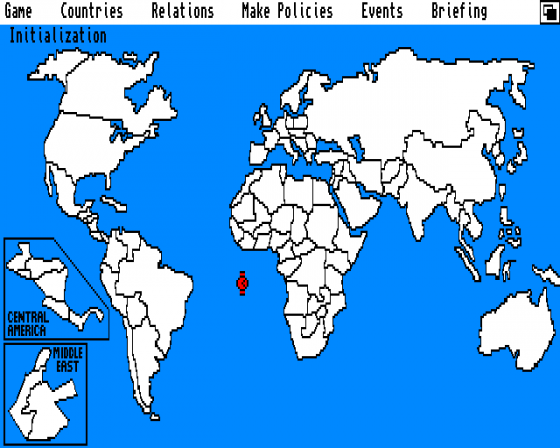
Zzap
 1st July 1989
1st July 1989
Categories: Review: Software
Publisher: Mindscape International Inc
Machine: Amiga 500
Published in Zzap #51
Balance Of Power: The 1990 Edition
The original Balance Of Power is widely recognised as one of the most ambitious games ever released, representing over 60 real countries in a tense, present-day power struggle between Russia and the United States. The 1990 Edition increases the number of countries to 80, updates the world situation and introduces a 'Multipolar' level, where smaller countries act less like superpower puppets and are free to start wars amongst themselves.
The simulation starts in the year 1989 and continues until 1997, unless a nuclear war is triggered. You can play either the US or USSR leader, and there's also a two-player option. If the world survives until '97 the winner is the one with the most prestige points, i.e. the most world influence. Each country has a certain amount of prestige points, calculated by their military power, and depending by how far they lean to you, a certain amount of their points go to you.
Initially, the superpowers have zero prestige points each, and the major events map is displayed with certain countries coloured red to show something important is happening to them - usually a civil war or revolution. The cynical heart of te game is backing right-wing rebels/governments against left-wing governments/rebels (if you're playing the US). How you act in the game is via the 'Make Policies' menu. Options include Military Aid, Aid to Insurgents, Intervene (send in the troops) for Government, Intervene for Rebels, Economic Aid, Destabilize (send in the CIA or RGB), sign a Treaty of support and use Diplomatic Pressure. Most of these options can be graduated (from zero aid to two billion dollars worth, for example).

To help you decide what to do there's a wealth of background information to be accessed, from which superpower a country is allied with to the number of TVs in a country. Setting US policy for every country would obviously take ages, so it's best to concentrate on where there's a crisis of some kind. A basic rule to remember here is the amount of support you can give to a country depends on whether you have an allied country nearby.
Once all your policies are set it's onto the next turn, or year, and there's a couple of minutes wait while the computer calculates the enemy response. In addition your game is automatically saved, so you can take back a turn if necessary.
When the new turn starts the USSR will normally have quite a few bones to pick with you over some of the decisions you've made - i.e. sending 2000 marines to Afghanistan. This is when crises begin. The first stage is a diplomatic note asking you to change policy. Withdraw the troops and you'll lose no prestige points. If you refuse to back down though, the Soviets could escalate to threats, including increasing their nuclear readiness, all the way up to a full nuclear war. In a change from the original version there are now four advisors to offer suggestions; these can of course be wrong, or simply state "It's too close to call"... which is all too common.

Once you start on the spiral of escalating threats and counter-threats the prestige points at stake rise dramatically, with all the world watching to see which superpower is strong, and which weak. And of course with so much prestige at stake the temptation is to escalate the crisis further, hoping to bluff your opponent. This increases the prestige points again, and raises the risk of accidental nuclear war - then deliberate nuclear war, when the temptation arises of 'hitting them first'.
Judging when to stand firm, and when to back down is the most critical and tense part of the game. Survive the Soviet challenges to your policies and then it's time for you to review their policies, challenging them as necessary and threatening to escalate if need be,
As you'd expect from a game designed for the monochromatic Apple Macintosh the graphics don't make best use of the Amiga. The world map and portraits of your policy advisors are the only graphics, while sound is non-existent. However, it's the gameplay that matters, and that is extraordinarily complex. The sheer number of countries, and large amount of information to be studied, is extremely impressive (there's a lot of in-game disk accessing, but usually very quick). For this reason it's no good loading the game without at least an hour or so to spend on one or two turns.

In short, if you've the patience and inclination to persist with it, this is an exceptionally involved and challenging game. But owners of the original be warned, the only addition for an extra £25 is the multipolar option.
Verdict
Presentation 70%
An informative 92 page manual and slick use of windows make a complex game relatively easy to understand, but graphics are poor and the lack of a better save facility is irritating.
Challenge 94%
82 countries and four different playing levels provide a very substantial challenge indeed.
Authenticity 87%
High, but random, elements soon create unreallistic touches as the game progresses
Overall 90%
A complex and involving game which will demand a lot of time to fully master.









